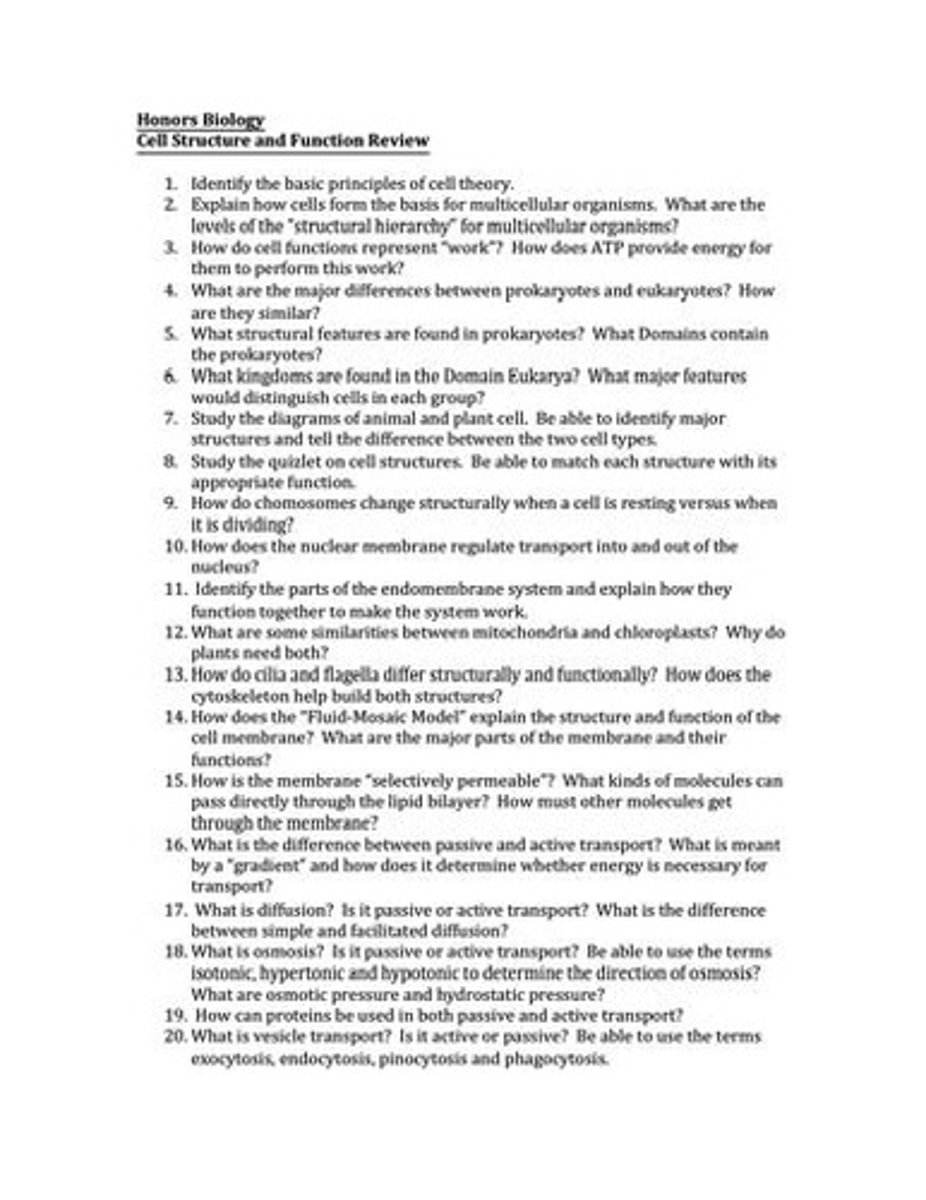Cell Structure and Function in Multicellular Organisms
1/42
There's no tags or description
Looks like no tags are added yet.
Name | Mastery | Learn | Test | Matching | Spaced |
|---|
No study sessions yet.
43 Terms
Multicellular Organisms
Cells form tissues, organs, and systems hierarchically.
Structural Hierarchy
Levels include cells, tissues, organs, systems, organisms.
Cell Functions
Cell activities represent biological work requiring energy.
Prokaryotes
Simple, unicellular organisms without a nucleus.
Prokaryotic Features
Lack nucleus, have cell walls, circular DNA.
Chromosome Structure
Condensed during division, relaxed when resting.
Fluid-Mosaic Model
Describes cell membrane's dynamic structure and function.
Active Transport
Requires energy to move substances against gradient.
Diffusion
Passive movement of molecules from high to low concentration.
Facilitated Diffusion
Passive transport via protein channels or carriers.
Osmosis
Diffusion of water across a selectively permeable membrane.
Hypotonic Solution
Lower solute concentration outside cell, causes swelling.
Osmotic Pressure
Pressure required to prevent water movement across membrane.
ATP
Adenosine triphosphate, energy currency of cells.
Eukaryotes
Complex cells with membrane-bound organelles.
Domains of Life
Bacteria and Archaea contain prokaryotic organisms.
Domain Eukarya
Includes kingdoms: Animalia, Plantae, Fungi, Protista.
Animal Cells
Lack cell walls, have centrioles and lysosomes.
Plant Cells
Contain cell walls, chloroplasts, and large vacuoles.
Nuclear Membrane
Regulates transport via nuclear pores.
Endomembrane System
Includes ER, Golgi, vesicles; functions in transport.
Mitochondria
Powerhouse of the cell, produces ATP.
Chloroplasts
Site of photosynthesis, converts sunlight to energy.
Cilia vs Flagella
Cilia are short, numerous; flagella are long, few.
Cytoskeleton
Provides structural support, aids in movement.
Selectively Permeable Membrane
Allows certain molecules to pass, blocking others.
Passive Transport
Movement without energy, down concentration gradient.
Isotonic Solution
Equal solute concentration inside and outside cell.
Hypertonic Solution
Higher solute concentration outside cell, causes shrinkage.
Hydrostatic Pressure
Pressure exerted by a fluid at equilibrium.
Protein Transport
Proteins assist in both passive and active transport.
Vesicle Transport
Active transport involving membrane-bound vesicles.
Exocytosis
Process of expelling materials from the cell.
Endocytosis
Process of taking materials into the cell.
Pinocytosis
Cell drinking; uptake of liquid substances.
Phagocytosis
Cell eating; uptake of large particles.
Enzymes
Biological catalysts that speed up chemical reactions.
Substrate
Reactant molecule upon which an enzyme acts.
Activation Energy
Energy required to initiate a chemical reaction.
Competitive Inhibitors
Compete with substrate for enzyme's active site.
Noncompetitive Inhibitors
Bind to enzyme, altering its function without competing.
Induced Fit
Enzyme changes shape to better fit substrate.
Cell Theory
All living organisms are composed of cells.
